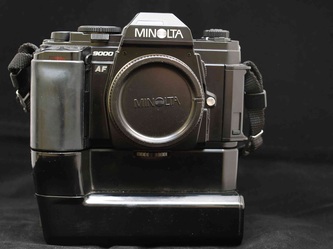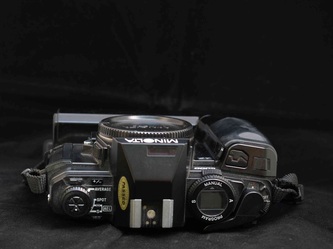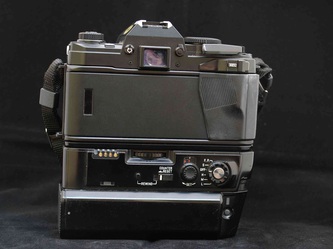Minolta 9000
Very soon after the 7000, Minolta introduced the professional 9000 in 1985. The Minolta 9000 still lumped on two thoughts. On the one hand it was the first professional SLR with autofocus. On the other hand the lay out resembled that of more traditional cameras like the Canon F1 or Nikon F3. For example film advance was still manual. With the additional motordrive it was possible to take pictures up to 5 frames per second. The motordrive though added considerable to size and weight.
AF of the 9000 is, like that of the 7000, slow. Without the motordrive or winder, the 9000 uses continuous autofocus. In my opinion a somewhat unusal choice. Especially with manual film advance one would expect a 'one shot' autofocus. Which means the shutter only releases after focussing, but also that focus is kept locked as long as the shutterbutton is depressed half. This had been a more sensible choice. Minolta chose different. With the motordrive added though, one can choose between continuous focus and 'one shot'. Choose 'F.P.' on the motordrive and you have 'one shot' autofocus.
The 9000 is a beautiful, very solid and reliable camera. Though the outside is mainly plastics, it's a durable and solid kind of plastic. I like this camera a lot, even today. For 'slow photography' the AF is fast enough and one can make beautiful pictures. Exposure is good and for difficult situations there's spot metering with the beautiful highlight and shadow options. For sports it's not your best choice.
A problem all 9000's have is the so called 'bleeding' of the top LCD. Which means black spots appear on the LCD. Usually it's only small and all the necessary readings are still possible. The 'bleeding' is different on every camera and as it appears, it seems to stop after some while also. This 'bleeding' shouldn't withhold you from buying this camera. Todays prices are a steal for such a rock solid camera.
Here's nice link that explains you everything about the Minolta 9000: http://www.9000.org/
AF of the 9000 is, like that of the 7000, slow. Without the motordrive or winder, the 9000 uses continuous autofocus. In my opinion a somewhat unusal choice. Especially with manual film advance one would expect a 'one shot' autofocus. Which means the shutter only releases after focussing, but also that focus is kept locked as long as the shutterbutton is depressed half. This had been a more sensible choice. Minolta chose different. With the motordrive added though, one can choose between continuous focus and 'one shot'. Choose 'F.P.' on the motordrive and you have 'one shot' autofocus.
The 9000 is a beautiful, very solid and reliable camera. Though the outside is mainly plastics, it's a durable and solid kind of plastic. I like this camera a lot, even today. For 'slow photography' the AF is fast enough and one can make beautiful pictures. Exposure is good and for difficult situations there's spot metering with the beautiful highlight and shadow options. For sports it's not your best choice.
A problem all 9000's have is the so called 'bleeding' of the top LCD. Which means black spots appear on the LCD. Usually it's only small and all the necessary readings are still possible. The 'bleeding' is different on every camera and as it appears, it seems to stop after some while also. This 'bleeding' shouldn't withhold you from buying this camera. Todays prices are a steal for such a rock solid camera.
Here's nice link that explains you everything about the Minolta 9000: http://www.9000.org/
| maxxum9000manual-part1.pdf | |
| File Size: | 2730 kb |
| File Type: | |
| maxxum9000manual-part2.pdf | |
| File Size: | 3079 kb |
| File Type: | |



